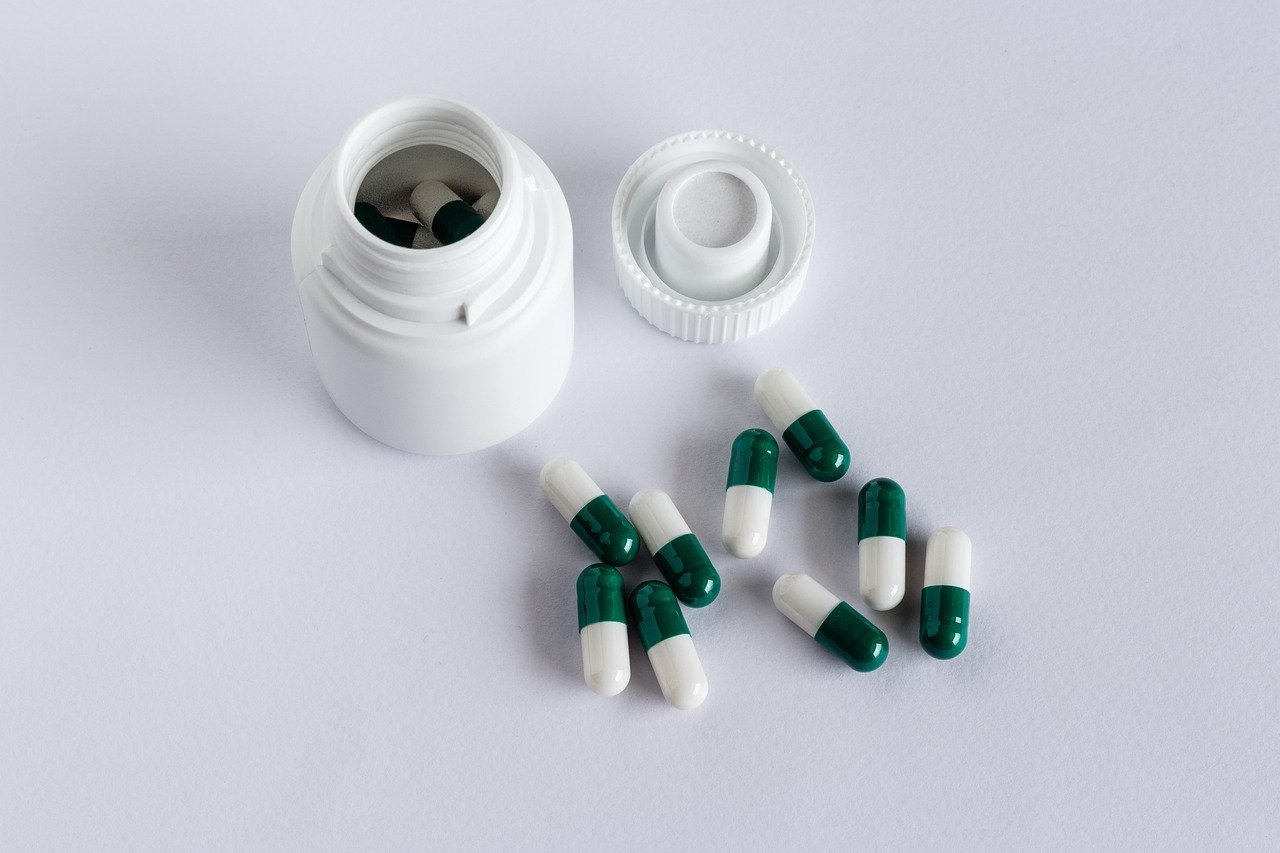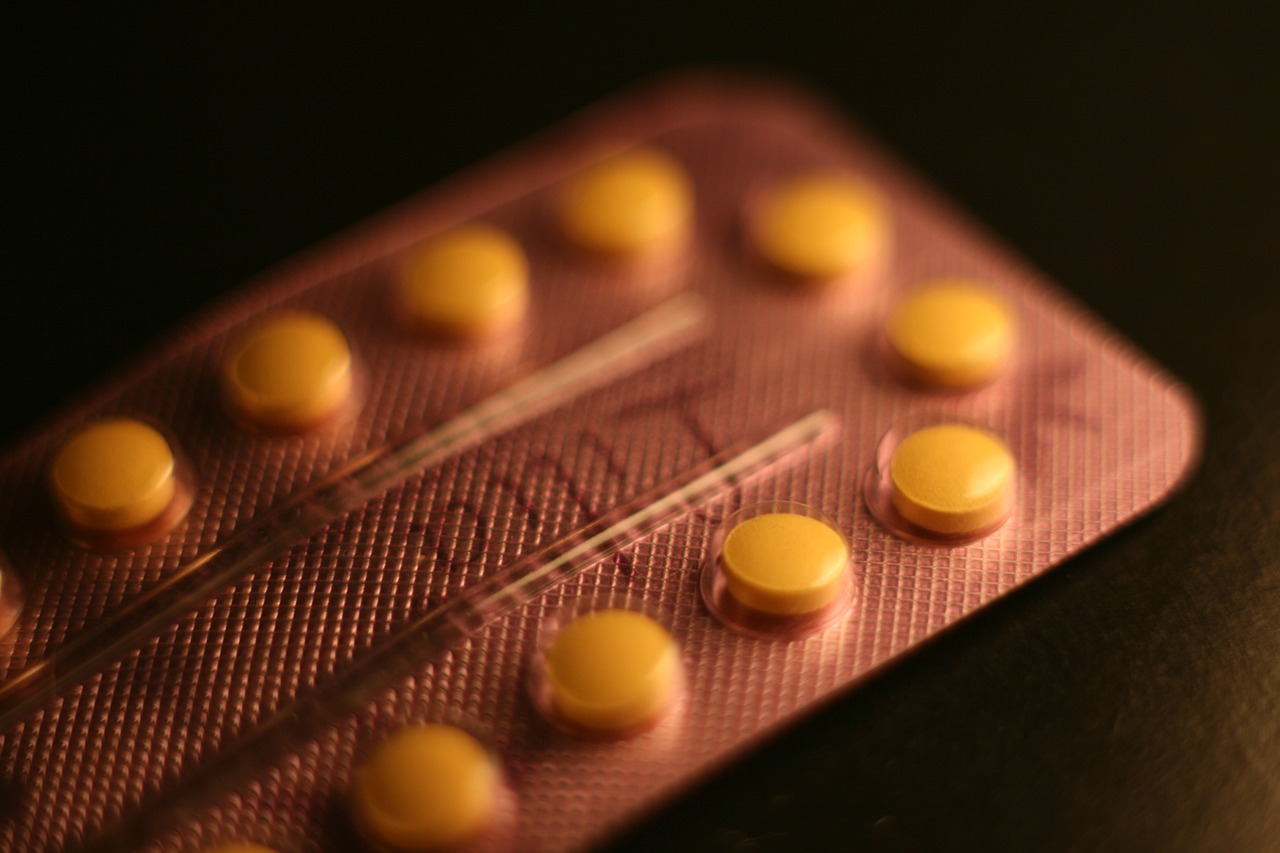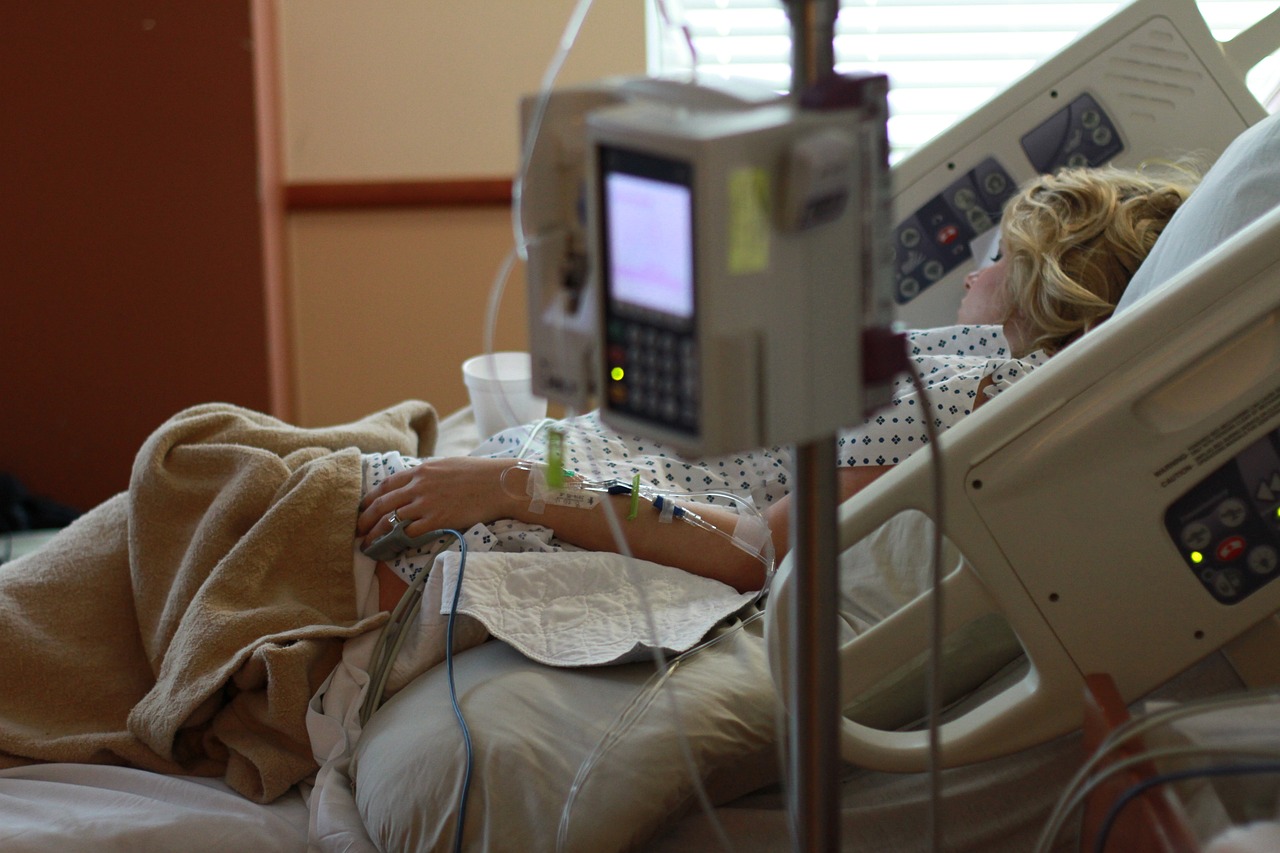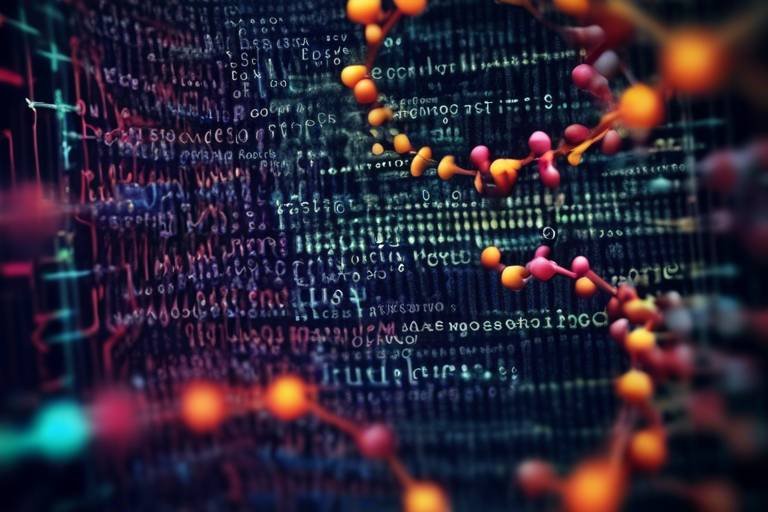The Role of Nanotechnology in Drug Delivery Systems
Nanotechnology is not just a buzzword; it's a revolutionary force that's reshaping the landscape of medicine, particularly in the realm of drug delivery systems. Imagine a world where medications can be delivered more effectively, side effects are minimized, and patients experience better outcomes. This is not science fiction—it's the reality that nanotechnology is creating. By manipulating materials on a molecular scale, researchers are developing innovative methods to enhance the efficacy of drugs, ensuring they reach their intended targets with precision. In this article, we will delve deep into how nanotechnology is transforming drug delivery systems, making treatments smarter and more effective.
At its core, nanotechnology involves the manipulation of matter on an atomic or molecular scale, typically within the range of 1 to 100 nanometers. This tiny scale opens up a world of possibilities in medicine, particularly in drug delivery. Think of it as a tiny delivery truck navigating through the bustling streets of the human body, ensuring that medications reach their destination without getting lost in the traffic of healthy cells. The benefits of nanotechnology in healthcare are profound:
- Targeted therapies: Delivering drugs directly to the site of action minimizes damage to healthy tissues.
- Personalized medicine: Tailoring treatments to individual patients based on their unique biological makeup.
- Improved bioavailability: Enhancing the solubility and absorption of drugs for better effectiveness.
By harnessing these advantages, nanotechnology is paving the way for a new era of medical treatments that are not only more effective but also safer for patients.
Understanding how nanotechnology facilitates drug delivery is crucial for grasping its impact on treatment effectiveness. There are two main mechanisms: passive and active targeting. Passive targeting takes advantage of the body's natural processes, while active targeting employs specific ligands to guide drugs to particular cells. Let's break these down further.
Passive targeting is like a well-planned heist where the drugs are stealthily delivered to their destination without raising alarms. This method utilizes the body’s natural mechanisms to direct nanoparticles to specific sites. The size and surface properties of nanoparticles play a significant role in this process. For instance, smaller nanoparticles can navigate through the bloodstream more effectively, akin to a small fish swimming through a coral reef, while larger particles may struggle to pass through blood vessels.
One of the key principles in passive targeting is the Enhanced Permeability and Retention (EPR) effect. This phenomenon occurs in tumor vasculature, where the blood vessels are more permeable than those in normal tissues. As a result, nanoparticles can accumulate in cancerous tissues more easily, much like a sponge soaking up water. This targeted accumulation not only enhances the effectiveness of cancer treatments but also minimizes side effects, allowing for higher doses of drugs to be administered safely.
The size and surface characteristics of nanoparticles are critical in determining their behavior in the body. By modifying these attributes, researchers can significantly improve the circulation time of drugs and enhance targeting precision. For example, nanoparticles can be engineered with specific surface charges or coatings to evade the immune system, allowing them to remain in circulation longer and reach their intended targets more effectively.
On the other hand, active targeting is like sending a personalized invitation to a party. It uses ligands—molecules that bind to specific receptors on target cells—to direct drugs exactly where they are needed. This method enhances the selectivity and effectiveness of treatments, reducing the risk of damaging healthy cells. By employing this approach, researchers can design nanoparticles that are not only smart but also incredibly precise in their delivery.
Various types of nanoparticles are employed in drug delivery systems, each with unique properties and applications in medicine. Here’s a brief overview:
Liposomes are spherical vesicles that can encapsulate drugs, acting as tiny delivery vehicles. Their advantages include excellent biocompatibility and the ability to improve drug solubility. This is particularly beneficial for hydrophobic drugs that struggle to dissolve in water, allowing them to be delivered more effectively.
Polymeric nanoparticles offer incredible versatility in drug delivery. They can be designed to release drugs at controlled rates, making them suitable for various therapeutic applications. This customization allows for targeted release profiles, ensuring that drugs are available at the right time and in the right amounts.
Despite the advancements, challenges remain in the field of nanotechnology for drug delivery. Issues such as toxicity, scalability, and regulatory hurdles pose significant obstacles. However, ongoing research and development are focused on overcoming these challenges, paving the way for future innovations that will enhance the efficacy and safety of nanotechnology-based drug delivery systems.
Q: What is nanotechnology?
A: Nanotechnology involves the manipulation of matter on an atomic or molecular scale, typically between 1 to 100 nanometers.
Q: How does nanotechnology improve drug delivery?
A: It enhances drug targeting, reduces side effects, and improves overall treatment efficacy by employing nanoparticles that can navigate the body more effectively.
Q: What are the types of nanoparticles used in drug delivery?
A: Common types include liposomes and polymeric nanoparticles, each with unique properties that facilitate drug delivery.

Introduction to Nanotechnology in Medicine
Nanotechnology is not just a buzzword; it's a game-changer in the field of medicine. Imagine a world where treatments are not only more effective but also tailored specifically to the individual needs of patients. This is the promise of nanotechnology, which operates at the molecular level, manipulating materials that are typically 1 to 100 nanometers in size. This tiny scale opens up a universe of possibilities for enhancing drug delivery systems, thereby improving patient outcomes.
At its core, nanotechnology allows for the development of targeted therapies. Rather than a one-size-fits-all approach, treatments can be customized based on a patient's unique genetic makeup, lifestyle, and the specific characteristics of their disease. This not only enhances the efficacy of medications but also significantly reduces the risk of side effects, making for a more pleasant treatment experience overall.
Moreover, the benefits of nanotechnology extend beyond just targeted therapies. The ability to encapsulate drugs within nanoparticles means that medications can be shielded from degradation in the body, ensuring that they remain effective until they reach their intended destination. This is where the magic of nanotechnology truly shines: it combines precision with efficiency, allowing for lower doses of medication to achieve the same, if not better, therapeutic results.
As we delve deeper into the mechanisms of drug delivery facilitated by nanotechnology, we will uncover the various methods, such as passive and active targeting, that are revolutionizing how we approach treatment. But before we get into the nitty-gritty, it’s essential to understand the foundational principles that make nanotechnology so impactful in the healthcare sector.
| Key Benefits of Nanotechnology in Medicine | Description |
|---|---|
| Targeted Drug Delivery | Enables medications to be delivered directly to diseased cells, minimizing harm to healthy cells. |
| Reduced Side Effects | Lower doses of drugs can be used, leading to fewer adverse reactions. |
| Improved Solubility | Enhances the solubility of poorly soluble drugs, increasing their bioavailability. |
| Personalized Medicine | Treatments can be tailored to individual patient profiles, enhancing effectiveness. |
In conclusion, the integration of nanotechnology into medicine is paving the way for a new era of healthcare. As we continue to explore its applications, the potential for improved efficacy and patient outcomes becomes increasingly evident. The next sections will delve into the mechanisms of drug delivery, illustrating how these tiny particles are making a huge impact in the fight against disease.

Mechanisms of Drug Delivery
Understanding the mechanisms by which nanotechnology facilitates drug delivery is crucial for appreciating how it enhances treatment outcomes. At its core, drug delivery via nanotechnology can be categorized into two primary methods: passive targeting and active targeting. Each of these methods employs unique strategies to ensure that therapeutic agents reach their intended destinations effectively, maximizing their efficacy while minimizing side effects.
Passive targeting relies on the natural processes of the body to direct nanoparticles to specific sites, particularly in the context of tumors. This method takes advantage of the differences in blood vessels between healthy tissues and tumors. Tumor vasculature is often leaky, allowing nanoparticles to seep through more easily than they would in normal tissues. This characteristic is known as the Enhanced Permeability and Retention (EPR) effect, which is a fundamental principle in passive targeting. By exploiting this effect, nanoparticles can accumulate in cancerous tissues, thereby increasing the concentration of the drug where it is most needed.
Within the realm of passive targeting, the size and surface properties of nanoparticles play a pivotal role in their distribution throughout the body. For instance, smaller nanoparticles can navigate through the bloodstream more efficiently and penetrate tissues more easily than larger counterparts. Additionally, the surface characteristics, such as charge and hydrophilicity, can influence how these particles interact with biological membranes, affecting their circulation time and overall effectiveness.
The EPR effect is a game-changer in the field of cancer treatment. By understanding how tumor blood vessels differ from normal ones, researchers can design nanoparticles that take advantage of this phenomenon. The accumulation of nanoparticles in tumors not only enhances drug concentration but also reduces systemic exposure, which can lead to fewer side effects. This targeted approach is akin to using a guided missile in warfare, where the goal is to hit the target with precision while avoiding collateral damage.
Modifying the size and surface of nanoparticles can significantly improve their performance in drug delivery. For example, researchers can engineer nanoparticles to have specific surface charges that enhance their ability to bind to target cells. Additionally, altering the size can affect how long the nanoparticles remain in circulation before being cleared by the body. Through careful design, scientists can create nanoparticles that are not only effective carriers of drugs but also possess the ability to evade the immune system, allowing for prolonged therapeutic action.
On the other hand, active targeting employs a more direct approach by utilizing ligands or antibodies that specifically bind to receptors on target cells. This method enhances the selectivity and effectiveness of treatments, ensuring that drugs are delivered precisely where they are needed. By attaching targeting moieties to the surface of nanoparticles, researchers can create a delivery system that functions like a key fitting into a lock, ensuring that the therapeutic agent is released only at the intended site.
Both passive and active targeting techniques highlight the incredible potential of nanotechnology in revolutionizing drug delivery systems. As we continue to explore these mechanisms, it becomes increasingly clear that the future of medicine may very well hinge on our ability to harness the power of nanoscale innovations to improve patient outcomes.
- What is nanotechnology in drug delivery? Nanotechnology in drug delivery refers to the use of nanoparticles to transport therapeutic agents to specific sites in the body, enhancing their efficacy and reducing side effects.
- How does passive targeting work? Passive targeting utilizes the body's natural processes, such as the EPR effect, to allow nanoparticles to accumulate in areas like tumors, where blood vessels are more permeable.
- What are the advantages of active targeting? Active targeting improves the selectivity of drug delivery by using ligands that bind specifically to target cells, ensuring that the treatment is more effective and minimizes damage to healthy tissues.
- What types of nanoparticles are commonly used? Common types of nanoparticles used in drug delivery include liposomes, polymeric nanoparticles, and dendrimers, each offering unique properties suited for various therapeutic applications.

Passive Targeting Techniques
When we talk about , we're diving into a fascinating world where the body’s own systems are harnessed to deliver drugs right where they’re needed most. Imagine a finely tuned delivery service that knows exactly where to drop off packages without needing a GPS. This is essentially what passive targeting does. By taking advantage of the natural processes of the body, specifically the unique characteristics of certain tissues and blood vessels, nanoparticles can be guided to their destination with remarkable precision.
One of the critical factors that influence the success of passive targeting is the size of the nanoparticles. Generally speaking, smaller particles can navigate through the body more easily, slipping through the gaps in blood vessels that are often larger in diseased tissues, like tumors. This phenomenon is known as the Enhanced Permeability and Retention (EPR) effect. The EPR effect allows nanoparticles to accumulate in areas of increased vascular permeability, such as tumors, where the blood vessels are more porous. This means that drugs can be delivered more effectively to cancerous cells while minimizing exposure to healthy tissues, thereby reducing side effects.
Additionally, the surface properties of nanoparticles play a significant role in their distribution within the body. For instance, modifying the surface charge or coating nanoparticles with specific materials can enhance their stability and circulation time in the bloodstream. A well-designed nanoparticle can evade the immune system, allowing it to remain in circulation longer and increasing the likelihood of reaching the targeted site. This is akin to a stealth vehicle that can move through traffic unnoticed, ensuring that it arrives at its destination without delays.
To illustrate the importance of size and surface modifications, consider the following table, which outlines some of the key attributes affecting drug delivery efficiency:
| Attribute | Impact on Drug Delivery |
|---|---|
| Particle Size | Smaller particles penetrate tissues more effectively, enhancing accumulation in target areas. |
| Surface Charge | Positive or negative charges can influence interactions with biological membranes and cells. |
| Coating Materials | Biocompatible materials can improve circulation time and reduce immune response. |
In summary, passive targeting techniques represent a groundbreaking approach in drug delivery systems. By utilizing the body’s natural mechanisms and optimizing the properties of nanoparticles, we can achieve more effective treatments with fewer side effects. As research in this area continues to evolve, we can expect even greater advancements that will enhance the precision and efficacy of therapies for various diseases.

Enhanced Permeability and Retention Effect
The Enhanced Permeability and Retention (EPR) effect is a fascinating phenomenon that plays a pivotal role in the effectiveness of nanotechnology in drug delivery systems, particularly in targeting cancerous tissues. Imagine a bustling city where certain neighborhoods are more accessible than others; this is akin to how blood vessels in tumors are structured. Tumor vasculature is often irregular and leaky, allowing nanoparticles to slip through more easily than they would in healthy tissues. This unique characteristic is what we refer to as the EPR effect, and it's a game-changer in how we approach cancer treatment.
When nanoparticles enter the bloodstream, their size and surface properties determine how effectively they can navigate through these leaky blood vessels. Generally, nanoparticles ranging from 10 to 100 nanometers in diameter are optimal for exploiting the EPR effect. Due to their small size, they can circulate longer in the bloodstream, increasing the likelihood of reaching the tumor site. Once there, they can accumulate in the tumor tissue, providing a higher concentration of the drug exactly where it's needed.
To illustrate the impact of the EPR effect, consider the following table:
| Parameter | Healthy Tissue | Cancerous Tissue |
|---|---|---|
| Vascular Permeability | Low | High |
| Nanoparticle Accumulation | Minimal | Significant |
| Drug Concentration | Uniform Distribution | Localized Delivery |
This table highlights the stark contrast between healthy and cancerous tissues regarding their ability to allow nanoparticles to permeate. The high vascular permeability in tumors facilitates a greater accumulation of therapeutic agents, enhancing the overall effectiveness of the treatment while minimizing side effects in healthy tissues.
Moreover, the EPR effect is not just limited to cancer therapy. It can also be leveraged for delivering drugs to other conditions where abnormal vasculature is present, such as in certain inflammatory diseases. However, it's essential to recognize that the EPR effect can vary significantly between individuals and tumor types, which poses a challenge for creating universally effective treatments. Researchers are actively exploring ways to optimize nanoparticle formulations and improve targeting strategies to maximize the benefits of the EPR effect.
In conclusion, the Enhanced Permeability and Retention effect is a cornerstone of modern nanotechnology in drug delivery. By understanding and harnessing this phenomenon, we can significantly improve the precision and efficacy of treatments, paving the way for a future where medicine is not just effective but also tailored to the individual needs of patients.
- What is the EPR effect?
The EPR effect refers to the tendency of nanoparticles to accumulate in tumor tissues due to the leaky nature of tumor blood vessels.
- How do nanoparticles exploit the EPR effect?
Nanoparticles can pass through the leaky blood vessels of tumors more easily than those in healthy tissues, leading to localized drug delivery.
- Are all nanoparticles suitable for exploiting the EPR effect?
No, only nanoparticles within a specific size range (typically 10-100 nanometers) are most effective at utilizing the EPR effect.
- Can the EPR effect be used in other diseases?
Yes, the EPR effect can also be beneficial in treating other conditions with abnormal blood vessel structures, such as inflammatory diseases.

Size and Surface Modifications
The size and surface characteristics of nanoparticles are pivotal in determining their effectiveness in drug delivery systems. Imagine nanoparticles as tiny delivery trucks navigating through the bloodstream; their size influences how easily they can maneuver through the complex network of blood vessels. Generally, nanoparticles range from 1 to 100 nanometers in diameter, and this size range is crucial for achieving optimal drug delivery. Smaller nanoparticles can penetrate tissues more effectively, while larger ones may be better suited for certain applications where prolonged circulation is desired.
Moreover, the surface modifications of these nanoparticles can significantly enhance their functionality. Think of the surface of a nanoparticle like the exterior of a vehicle; just as a car's design can affect its aerodynamics and fuel efficiency, the surface properties of nanoparticles influence their interactions with biological systems. For instance, modifying the surface with specific ligands can improve targeting capabilities, allowing the nanoparticles to bind selectively to diseased cells. This selective targeting not only enhances the therapeutic efficacy but also minimizes side effects, as the drugs are delivered more directly to the intended site of action.
Additionally, the surface charge of nanoparticles plays a crucial role in their behavior within the body. Nanoparticles can be engineered to have positive, negative, or neutral charges, which can affect their stability, distribution, and cellular uptake. For example, positively charged nanoparticles often exhibit better cellular uptake due to their attraction to negatively charged cell membranes. However, balancing these properties is essential, as overly charged nanoparticles may trigger immune responses or be rapidly cleared from circulation.
To summarize, the size and surface modifications of nanoparticles are not just technical details; they are fundamental aspects that dictate the success of drug delivery systems. By carefully engineering these properties, researchers can create nanoparticles that not only deliver drugs more effectively but also improve patient outcomes. The ongoing research in this area is like a treasure hunt, where scientists are constantly seeking the perfect combination of size and surface characteristics to unlock the full potential of nanotechnology in medicine.
- What are nanoparticles? Nanoparticles are extremely small particles that range from 1 to 100 nanometers in size, used in various applications, including drug delivery.
- How do size and surface modifications affect drug delivery? The size influences how nanoparticles navigate through the body, while surface modifications can enhance targeting and reduce side effects.
- What is the significance of surface charge in nanoparticles? The surface charge affects stability and cellular uptake, influencing how effectively a nanoparticle can deliver its drug payload.
- Are there any risks associated with using nanoparticles in medicine? While nanoparticles can improve drug delivery, there are potential risks, such as immune responses or toxicity, that researchers are actively investigating.

Active Targeting Techniques
Active targeting techniques in drug delivery systems represent a significant leap forward in how we approach treatment. Unlike passive targeting, which relies on the body's natural processes to deliver drugs to specific sites, active targeting employs specific ligands that bind to receptors on the surface of target cells. Imagine a guided missile that only strikes its intended target, minimizing collateral damage—this is what active targeting aims to achieve in the realm of medicine.
One of the most remarkable aspects of active targeting is its ability to enhance the selectivity of drug delivery. By utilizing ligands, such as antibodies or small molecules, researchers can create nanoparticles that home in on particular cells, such as cancer cells, while sparing healthy ones. This specificity not only increases the treatment's effectiveness but also reduces the likelihood of adverse side effects, which is a game-changer for patient care.
To illustrate how active targeting works, consider the following example: nanoparticles coated with antibodies can specifically bind to antigens that are overexpressed on the surface of tumor cells. Once the nanoparticles are attached to the cancer cells, they can deliver their therapeutic payload directly into the cell, ensuring that the drug is released exactly where it is needed. This method can be likened to a key fitting into a lock—only the right key (the ligand) can open the door (the target cell).
Moreover, the effectiveness of active targeting can be influenced by several factors, including:
- Ligand Selection: The choice of ligand is crucial; it must have a strong affinity for the target cell's receptor.
- Nanoparticle Design: The size, shape, and surface properties of the nanoparticles can significantly affect their interaction with target cells.
- Drug Release Mechanism: Understanding how the drug is released once inside the target cell is vital for maximizing therapeutic effects.
Despite its advantages, active targeting does come with its own set of challenges. For instance, the complexity of biological systems means that not all targeted nanoparticles will successfully bind to their intended cells. Additionally, the potential for immunogenic responses to the ligands can complicate matters. However, ongoing research is continually addressing these hurdles, paving the way for more effective treatments.
In summary, active targeting techniques are revolutionizing drug delivery by enhancing selectivity and efficacy. By harnessing the power of ligands to direct therapies to specific cells, we are moving closer to a future where treatments are not only more effective but also safer for patients. As we continue to explore and refine these methods, the possibilities for improved patient outcomes are truly exciting.
- What is active targeting in drug delivery?
Active targeting refers to the use of specific ligands that bind to receptors on the surface of target cells, allowing for more precise delivery of therapeutic agents. - How does active targeting improve drug efficacy?
By directing drugs specifically to target cells, active targeting increases the concentration of the drug at the site of action while minimizing exposure to healthy cells. - What are some challenges associated with active targeting?
Challenges include the complexity of biological systems, potential immunogenic responses, and the need for precise nanoparticle design.

Types of Nanoparticles Used
When it comes to nanotechnology in drug delivery systems, the choice of nanoparticle is crucial. Various types of nanoparticles are employed, each with unique properties and advantages that make them suitable for specific therapeutic applications. Understanding these types not only helps in appreciating their roles but also in recognizing how they can transform treatment methodologies. Let’s dive into some of the most common types of nanoparticles used in the field.
One of the most widely recognized types of nanoparticles is liposomes. These are spherical vesicles that can encapsulate drugs within their lipid bilayer, offering a biocompatible solution for drug delivery. The advantages of liposomes are numerous:
- Biocompatibility: Liposomes are generally well-tolerated by the body, minimizing adverse reactions.
- Improved Drug Solubility: They can enhance the solubility of hydrophobic drugs, making them more effective.
- Controlled Release: Liposomes can provide sustained release of drugs, improving therapeutic outcomes.
Another significant type is polymeric nanoparticles. These nanoparticles are made from natural or synthetic polymers and offer remarkable versatility in drug delivery. Their design can be tailored for specific therapeutic applications, allowing for:
- Customizable Release Profiles: By altering the polymer composition, the release rate of the drug can be controlled.
- Targeted Delivery: Surface modifications can enhance the targeting capabilities of these nanoparticles.
- Encapsulation of Various Drugs: They can encapsulate a wide range of therapeutic agents, including proteins, nucleic acids, and small molecules.
Additionally, we have gold nanoparticles, which have gained attention due to their unique optical properties and biocompatibility. They can be used for imaging and as carriers for targeted drug delivery, especially in cancer therapy. Their ability to be easily functionalized with various agents allows for enhanced targeting and efficacy.
Moreover, silica nanoparticles are also noteworthy. These nanoparticles offer high surface area and tunable pore sizes, making them ideal for drug loading and release. They can be engineered to respond to specific stimuli, such as pH or temperature, allowing for controlled drug release in targeted areas.
In summary, the selection of nanoparticles in drug delivery systems is not a one-size-fits-all approach. Each type has its own set of advantages and applications, making it essential to choose the right one based on the therapeutic needs. The landscape of nanoparticle technology is continually evolving, opening doors to new possibilities in medicine.
Q1: What are nanoparticles?
Nanoparticles are tiny particles that range in size from 1 to 100 nanometers. They are used in various fields, including medicine, for drug delivery, imaging, and diagnostics.
Q2: How do liposomes improve drug delivery?
Liposomes improve drug delivery by encapsulating drugs in a biocompatible lipid bilayer, enhancing solubility, and allowing for controlled release.
Q3: What advantages do polymeric nanoparticles offer?
Polymeric nanoparticles offer customizable release profiles, targeted delivery capabilities, and the ability to encapsulate a wide range of therapeutic agents.
Q4: Are gold nanoparticles safe for use in humans?
Gold nanoparticles are generally considered safe for use in humans, but extensive research is ongoing to ensure their safety and efficacy in medical applications.

Liposomes
Liposomes are fascinating structures in the realm of drug delivery, acting as tiny, spherical vesicles that can encapsulate therapeutic agents. Think of them as little delivery trucks that transport medications directly to the target site in the body. These vesicles are primarily composed of phospholipid bilayers, which mimic cell membranes, allowing for enhanced biocompatibility and reduced toxicity. This unique structure not only improves the solubility of hydrophobic drugs but also protects them from degradation, ensuring they reach their intended destination intact.
One of the standout features of liposomes is their ability to modify the pharmacokinetics of drugs. By encapsulating medications, liposomes can significantly enhance their circulation time in the bloodstream. This prolonged presence in circulation allows for lower dosages of drugs to be used, which can minimize side effects and improve patient compliance. Furthermore, liposomes can be engineered to release their payload in a controlled manner, providing sustained therapeutic effects over time.
There are various types of liposomes that can be utilized depending on the specific needs of the treatment. For instance, conventional liposomes are typically used for passive targeting, while stealth liposomes are modified to evade the immune system, resulting in extended circulation times. Additionally, targeted liposomes can be designed with ligands that bind to specific receptors on target cells, enhancing the selectivity of drug delivery.
| Type of Liposome | Description | Applications |
|---|---|---|
| Conventional Liposomes | Basic liposomes for passive targeting. | General drug delivery. |
| Stealth Liposomes | Modified to avoid the immune system. | Chronic conditions requiring long-term therapy. |
| Targeted Liposomes | Engineered with specific ligands. | Cancer therapies and localized treatments. |
In summary, liposomes represent a significant advancement in drug delivery systems, offering numerous advantages such as improved solubility, reduced toxicity, and targeted delivery. As research continues to evolve, the potential applications of liposomes in treating various diseases, particularly cancer, are expanding rapidly. With ongoing innovations in liposome technology, we can expect to see even more effective and personalized treatment options in the near future.
- What are liposomes made of? Liposomes are primarily composed of phospholipid bilayers that encapsulate drugs.
- How do liposomes improve drug delivery? They enhance solubility, protect drugs from degradation, and allow for targeted delivery.
- What types of drugs can be delivered using liposomes? Liposomes can deliver a variety of drugs, including hydrophobic and hydrophilic medications.
- Are liposomes safe for patients? Yes, liposomes are designed to be biocompatible and reduce toxicity compared to traditional drug delivery methods.

Polymeric Nanoparticles
Polymeric nanoparticles have emerged as a versatile and promising platform in the realm of drug delivery systems. These tiny carriers, typically ranging from 1 to 1000 nanometers in size, are made from biodegradable polymers, allowing them to encapsulate a variety of therapeutic agents, including small molecules, proteins, and nucleic acids. The beauty of polymeric nanoparticles lies in their ability to be tailored for specific therapeutic applications, which not only enhances the efficacy of the drugs but also minimizes potential side effects. Imagine these nanoparticles as tiny delivery trucks, designed to transport the right medication to the right location in the body, ensuring that the treatment is both effective and safe.
One of the key advantages of polymeric nanoparticles is their biocompatibility. This characteristic is crucial because it means that the body can accept these carriers without triggering unwanted immune responses. Furthermore, polymeric nanoparticles can be engineered to have specific surface properties, which can influence how they interact with biological systems. For instance, the surface can be modified to include targeting ligands, allowing these nanoparticles to home in on specific cells, such as cancer cells, much like a guided missile. This targeted approach not only improves drug delivery efficiency but also reduces the risk of damage to healthy tissues.
Another significant benefit of polymeric nanoparticles is their ability to control the release of drugs over time. This sustained release mechanism is akin to a slow-release medication, where the drug is gradually released into the bloodstream, maintaining therapeutic levels for a more extended period. This is particularly beneficial for chronic conditions where patients require consistent medication levels without the need for frequent dosing. The release profile can be tailored by adjusting the polymer's composition and structure, allowing for a customized approach to treatment.
To illustrate the versatility of polymeric nanoparticles, consider the following applications:
- Oncology: Targeted delivery of chemotherapeutics to tumor sites, enhancing treatment efficacy while minimizing systemic toxicity.
- Gene Therapy: Encapsulation of genetic material for targeted delivery to cells, facilitating the treatment of genetic disorders.
- Vaccines: Use of polymeric nanoparticles as carriers for antigens, improving immune response and stability of vaccines.
Moreover, the production of polymeric nanoparticles can be achieved through various methods, including solvent evaporation, nanoprecipitation, and emulsion techniques. Each method has its advantages and can be chosen based on the desired properties of the final product. For example, solvent evaporation allows for the encapsulation of hydrophobic drugs, while nanoprecipitation is often used for hydrophilic compounds.
Despite their numerous advantages, challenges remain in the development and application of polymeric nanoparticles. Issues such as scalability in production, regulatory hurdles, and the need for extensive safety evaluations can complicate their transition from the laboratory to clinical use. However, ongoing research is addressing these challenges, paving the way for more effective and safer drug delivery systems in the future.
- What are polymeric nanoparticles?
Polymeric nanoparticles are tiny carriers made from biodegradable polymers that can encapsulate various therapeutic agents for drug delivery. - How do polymeric nanoparticles improve drug delivery?
They enhance drug delivery by providing targeted therapy, controlling drug release, and improving the biocompatibility of the drugs. - What are the applications of polymeric nanoparticles?
They are used in oncology, gene therapy, and vaccine development, among other fields.

Challenges and Future Directions
While the integration of nanotechnology into drug delivery systems has shown promising results, it is not without its challenges. One of the most significant hurdles is ensuring the safety and biocompatibility of nanoparticles. As these tiny particles interact with biological systems, there is a concern regarding their potential toxicity. Researchers are actively investigating the long-term effects of nanoparticles in the body, as well as their interactions with various cell types. The complexity of biological systems makes it difficult to predict how nanoparticles will behave once administered, leading to the necessity for extensive testing and regulation.
Another challenge lies in the manufacturing and scalability of nanotechnology-based drug delivery systems. The production of nanoparticles must be consistent and reproducible to ensure that they meet safety and efficacy standards. This involves not only technical challenges but also significant financial investments. As the industry moves forward, developing cost-effective manufacturing techniques will be crucial in making these advanced therapies accessible to a broader patient population.
Moreover, the regulatory landscape for nanomedicine is still evolving. Regulatory bodies are grappling with how to classify and evaluate these novel materials. The lack of standardized testing methods can hinder the approval process, delaying the availability of innovative therapies. Collaboration between researchers, manufacturers, and regulators is essential to establish clear guidelines that ensure patient safety while fostering innovation.
Looking ahead, the future of nanotechnology in drug delivery systems is bright, but it requires a concerted effort to overcome these challenges. Researchers are exploring various strategies to enhance the efficacy and targeting precision of nanoparticles. For instance, the development of smart nanoparticles that can respond to specific stimuli, such as pH changes or temperature variations, holds great promise. These advanced systems could allow for controlled drug release, minimizing side effects and maximizing therapeutic effects.
In addition, the advent of personalized medicine offers an exciting direction for nanotechnology. By tailoring drug delivery systems to individual patient profiles, including their genetic makeup and disease characteristics, healthcare providers can improve treatment outcomes significantly. This approach not only enhances the effectiveness of therapies but also reduces the likelihood of adverse reactions.
To summarize, while there are considerable challenges to address in the field of nanotechnology for drug delivery, the potential benefits are enormous. The ongoing research and development efforts will likely lead to groundbreaking advancements that could transform the landscape of medicine. With time, we can expect to see more effective, safer, and personalized treatment options emerging from this rapidly evolving field.
- What are the main challenges faced by nanotechnology in drug delivery?
The primary challenges include safety and biocompatibility concerns, manufacturing scalability, and regulatory hurdles. - How can nanotechnology improve drug delivery?
Nanotechnology can enhance drug delivery by enabling targeted therapies, improving drug solubility, and allowing for controlled release mechanisms. - What is the future of nanotechnology in medicine?
The future includes advancements in smart nanoparticles, personalized medicine, and improved manufacturing techniques to make therapies more accessible.
Frequently Asked Questions
-
What is nanotechnology in drug delivery?
Nano-what? Nanotechnology is like the tiny superhero of medicine! It involves manipulating materials at the nanoscale to create innovative drug delivery systems. This means we can target therapies more precisely, enhance drug efficacy, and reduce those pesky side effects. Think of it as using a laser beam instead of a sledgehammer to hit the right spot!
-
How does passive targeting work in drug delivery?
Imagine a delivery truck that knows exactly where to drop off packages without needing a GPS! Passive targeting takes advantage of the body's natural processes to direct drugs to specific areas. By using nanoparticles that are just the right size, they can sneak into tissues and tumors more effectively, thanks to the Enhanced Permeability and Retention (EPR) effect. It's like finding a shortcut through a busy city!
-
What are the different types of nanoparticles used in drug delivery?
There’s a whole toolbox of nanoparticles out there! Some of the most common types include liposomes and polymeric nanoparticles. Liposomes are like little bubbles that can carry drugs safely, while polymeric nanoparticles can be customized for specific therapies. Each type has its own unique properties, making them perfect for different medical applications!
-
What challenges does nanotechnology face in drug delivery?
Even superheroes have their weaknesses! In the world of nanotechnology, challenges include ensuring safety, achieving consistent drug release, and overcoming biological barriers. Researchers are working hard to tackle these issues, so we can unlock the full potential of nanotechnology for better health outcomes.
-
How does active targeting differ from passive targeting?
Active targeting is like sending out a personal invitation to the right party! Instead of just hoping the drugs find their way, this method uses ligands to specifically direct them to certain cells. This targeted approach enhances the selectivity and effectiveness of treatments, making it a powerful strategy in the fight against diseases.



















